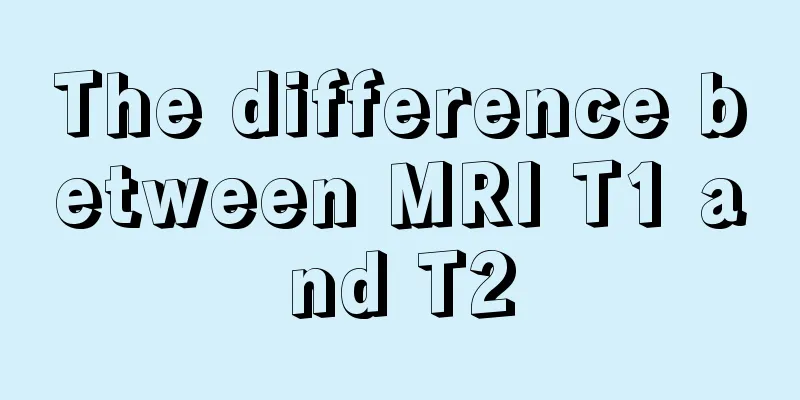The difference between MRI T1 and T2

|
Magnetic resonance imaging is a common examination in life. It is widely used and can be used to examine any part of the body. Compared with traditional examination methods, MRI examination is very clear, which is particularly helpful for doctors to make judgments. However, when doing MRI, there are usually T1 and T2. Generally, people are not very clear about this. What are the differences between MRI T1 and T2? What are the differences between T1 and T2 MRI? 1. Magnetic resonance (MR); the absorption and release of electromagnetic energy by nuclei (hydrogen protons) in a constant magnetic field after being excited by corresponding radio frequency pulses is called magnetic resonance. 2. TR (repetition time): also known as repetition time. The signal of MRI is very weak. In order to improve the signal-to-noise ratio of MR, it is required to repeatedly use the same pulse sequence. The interval time between repeated excitations is called TR. 3. TE (echedelay time): also known as echo time, which is the time between the emission of the RF pulse and the collection of the echo signal. 4. Sequence: refers to the pulse program-combination used in the examination. Commonly used ones are spin echo (SE), fast spin echo (FSE), gradient echo (GE), inversion recovery sequence IR), and planar echo sequence (EP). 5. Weighted image (weightimage.WI): In order to judge the various parameters of the detected tissue, the repetition time TR is adjusted. The echo time TE can produce an image that highlights certain tissue characteristic parameters. This image is called a weighted image. 6. Flowing void effect: The blood in the cardiovascular system flows rapidly, causing the hydrogen protons that emit MR signals to leave the receiving range, and the MR signals cannot be detected. 7. MR vascular imaging: There are two modes of vascular imaging, one is the time off light or TOF method; the other is the phase contrast or PC method. The former uses the longitudinal vector changes between the proton groups in the blood flow and the static tissue to create images, while the latter uses phase contrast changes to distinguish the surrounding static tissue and highlight the reconstructed vascular image. Currently, the TOP method is widely used in clinical practice. 8. MR water imaging: Based on the TW2 image, other tissues can be suppressed and only static water can be displayed. This technology can be used for ventriculography, bile duct imaging, urinary tract imaging, etc. 9. Relaxation: Under the excitation of radio frequency pulses, hydrogen protons in human tissue absorb energy and are in an excited state. After the RF pulse ends, the excited hydrogen protons return to their original state, a process called relaxation. 10. T1 is the so-called longitudinal relaxation time, which means how long it takes for the proton to return to its initial position on the positive z-axis after you magnetize it to the negative z-axis. T2 is the transverse relaxation time, which means how long it takes for a magnetization to decay to zero after it is generated in the transverse plane. T2* is shorter than T2 because of the gradient or other factors that make the field inhomogeneous, the transverse magnetization will decay to 0 faster. |
>>: Can a five month old baby sit?
Recommend
What are the early symptoms of bladder cancer
Bladder cancer is a malignant tumor. Many people ...
How to deal with cracked toenails
I believe that everyone must not care much about ...
The baby suddenly cried loudly while sleeping at night
Sleep is the most important thing in early childh...
What is the normal heart rate of a person
Nowadays, many people are concerned about their h...
Can one embryo be twins?
The embryonic bud is very important for both preg...
How to distinguish male and female parrot fish
When it comes to raising fish at home, many peopl...
What causes back pain and leg soreness? How to treat it?
Back pain and leg soreness are annoying symptoms ...
What kind of tea is good for your throat
In fact, many people pay great attention to their...
What does a positive EB virus antibody mean?
Viruses are more harmful than bacteria. Bacteria ...
What are the early symptoms of heart disease?
Heart disease poses a great threat to humans, so ...
What causes elbow eczema
Eczema is a very common phenomenon in daily life,...
The harm of humidifier to babies
We all know that many electronic products develop...
What Chinese medicine prescription should be taken for throat cancer
Laryngeal cancer is one of the most common tumors...
How to treat cervical precancerous lesions? What are the treatments for cervical precancerous lesions?
After the treatment and recovery of cervical prec...
Symptoms of colon inflammation_Symptoms of colitis
The intestines are a place that is prone to infec...









